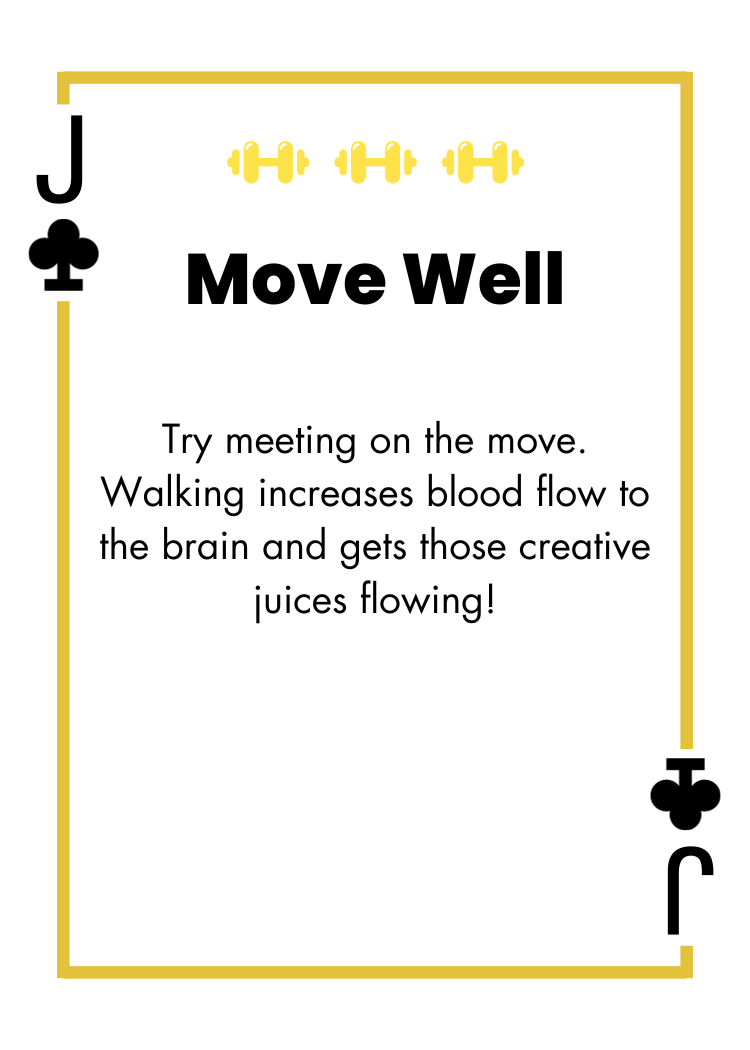Jack of Clubs - Standing Meeting

The normal meeting usually consists of team members sitting around a table. Try instead conducting a team meeting standing up to reduce sedentary time. Standing meetings are commonplace in the software development business as standing during meetings is used for short daily team briefings

Stand up during meetings! Start off with a short increment of standing to limit fatigue and build up to longer durations. Employers should engage in role-modelling standing during meetings behaviours. They can introduce a standing culture across the organisation, and this will allow people to feel more comfortable standing if others are doing the same. Additionally, managers and senior staff should be encouraged to initiate and role model standing as much as possible. This can be carried out in the following ways:
- Hold stand-up management meetings.
- Managers take the lead in standing at staff meetings and make everyone else.
Ideally, change the sitting meeting culture. Standing meetings are often shorter and more productive. Here are some ways this can be achieved:
- Promote a culture that is standing-friendly by announcing at the beginning of meetings that attendees are welcome and encouraged to stand.
- Schedule stand up or activity breaks in meetings.
- Put “Standing meetings welcome” signs in meeting rooms.
- Update meeting agenda templates to include at least one agenda item during which everyone stands.
- Move chairs out of meeting rooms or stack them at one end.
- For meetings conducted via video conference, set the default camera position at standing height.
- Encourage walking meetings. These work best for small, informal meetings with two or three people.
Physical inactivity at work has increased in recent years throughout the world increasing the risk of obesity, heart disease, stroke, and diabetes.
Extended sedentary time relates to detrimental health outcomes and is independent of individual physical activity levels. Sitting in the workplace significantly contributes to increased sedentary time.
Aside from the reduction in workplace sitting, further benefits that were also described by participants, included: increased productivity, improved workplace culture, decreased stress, increased awareness of the health benefits of sitting less, and improved physical health
In terms of the science behind standing and/or walking meetings, walking meetings both reduced sitting time and felt more efficient in terms of use of time for the people participating in these types of meetings.
Breaking up sitting frequently with periods of standing and associated light activity can have important health benefits. Standing helps to burn more calories which can improve the way our body uses glucose and may reduce the risk of cardiometabolic diseases. Standing may encourage overall promote more physical activity at work.
Benjamin Gardner Lee Smith and Louise Mansfield. (2019, November 5). Why you should definitely stand in meetings (and not care what others think about it). Workplace Insight. https://workplaceinsight.net/why-you-should-definitely-stand-in-meetings-and-not-care-what-others-think-about-it/
Mackenzie, K., Goyder, E. & Eves, F. (2015). Acceptability and feasibility of a low-cost, theory-based, and co-produced intervention to reduce workplace sitting time in desk-based university employees. BMC Public Health 15, 1294 https://doi.org/10.1186/s12889-015-2635-z
Mansfield L, Hall J, Smith L, Rasch M, Reeves E, Dewitt S, et al. (2018) “Could you sit down please?” A qualitative analysis of employees’ experiences of standing in normally-seated workplace meetings. PLoS ONE 13(6): e0198483. https://doi.org/10.1371/journal.pone.0198483
A guide to sitting less & moving more – HPA.ORG.NZ. (n.d.). https://www.hpa.org.nz/sites/default/files/documents/SLMM%20Guide.pdf
(Tips adapted from Health Promotion Agency, New Zealand -A Guide to Sitting Less & Moving More).

 See Other Cards!
See Other Cards!